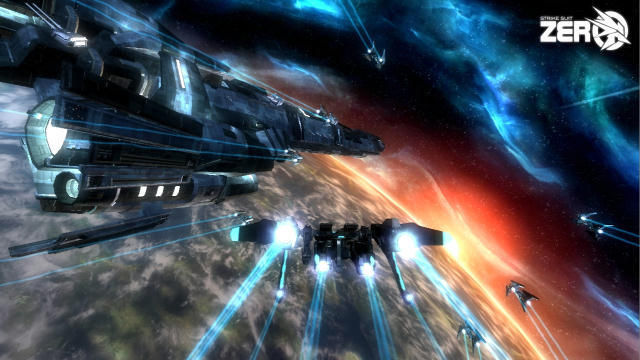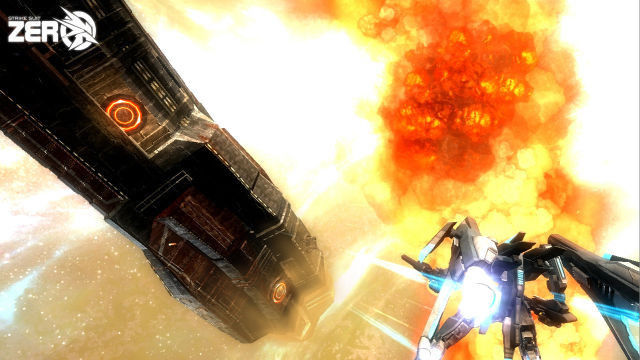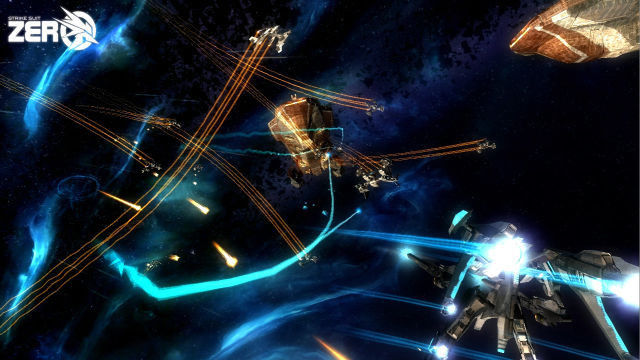Thanks to the determination of a small group of developers and the bottomless pit crowd-sourced funding of Kickstarter campaigns however, we’re about to see a resurgence of gravity-free combat the likes of which hasn’t been witnessed since the ‘90s. Strike Suit Zero, created by Born Ready Games, is one of the first out of the hangar into this new world.
 |
| Ah, space. Welcome back! |
It’s time for a genre to play catch up then, but you might not realise that from the opening few missions of Strike Suit Zero’s campaign. Jumping into the cockpit of your fighter craft and engaging war with enemy ships on behalf of humanity (the plot is a mish-mash of the galactic federation vs renegade colonists concept so beloved of many a sci-fi series) is a familiar and comfortable experience, with only the beautiful skyboxes, high-res graphics and litany of special effects betraying that this is a game developed for release in 2013. The front-end and UI is sparse and functional, with little in the way of polish.
The basic hook in the majority of Strike Suit Zero's missions comprises of dogfighting against small and nimble enemy craft, peppered with a few strafing runs on larger-scale ships capable of launching slow-moving torpedoes towards whichever designated target you’re protecting at the time. Your basic weapon systems comprise of an unlimited energy cannon that fires slow-moving bursts of plasma towards your targeting reticule (enemy ships have a lead indicator to assist with the aiming process), a machine gun that specialises in whittling down shields and a variety of lock-on or manual aim missiles that come in single-fire or swarm varieties depending on your chosen load-out. Progressing further unlocks different ships with different munitions capabilities to customise your armoury, with various stat boosts unlocked for achieving some tough optional mission goals.
In terms of basic gameplay, Strike Suit Zero's combat is gratifying and engaging. Whichever craft you choose, you’ll be able to tail your enemies with simplistic fluidity (there are two pace controls and a brake to allow you to turn sharply), blitz their shield and then go in for the kill with heavier munitions. Incoming enemy missiles are announced with a tracking sound that grows increasingly frantic as they approach, with a quick tap of a button dismissing their threat with the release of deflective materials from your thrusters - provided you have enough of their (regenerating) power to do so. Control on either gamepad, joystick or mouse and keyboard is reactive and easy enough to pick up and learn, although the bounding-box aiming of the mouse and keyboard setup offers considerable advantages to accuracy. And you may need that, as Strike Suit Zero is a tough, tough game at times.
As if to counter that point, mission 3 unlocks the box feature of Born Ready’s new franchise - the ability to switch your craft from speedy fighting vessel into a stationary anime-inspired mech behemoth. A third gameplay meter (on top of shield and hull health) is introduced to accommodate your new-found power, requiring regular top-ups by destroying enemy spacecraft and targets in normal flight mode.
 |
| Destruction is suitably visceral. |
That ability is, as you might expect, quite gratifying to behold, with the Strike Suit’s huge cannon and multiple lock-on missiles filling the screen with neon-tinged destruction as your brief burst of power enables the decimation of all targets in your path. There are drawbacks though. The reduced movement speed makes you liable to become a sitting duck whenever you make the change, and the time that it takes you to transform and get back up to speed can become all that matters when it comes down to the sliver of remaining hull strength drained by incoming fire. Utilising the Strike Suit functionality against larger targets does afford a few more tactical opportunities however, and indeed the multiple lock-on missiles can be useful when dealing with swarms of smaller enemies and/or torpedoes.
In action, when all those elements tie together, Strike Suit Zero can be exhilarating to play. Boosting into the action (the battles look spectacular from a distance), dodging a missile, making a sharp turn to tail your target, popping open their hull and then unleashing the Strike Suit before powering off into space to regenerate your shields is a fantastic buzz, and likely the exact sort of feeling that genre stalwarts have missed for all these years. There are, however, some serious problems with Born Ready’s structural and mission design, and they serve to undermine the project as a whole.
The first and most heinous crime is a cruel lack of mid-mission checkpointing in combination with some unfair difficulty spikes. Although missions generally last between 20-30 minutes, you’ll be lucky to get maybe two or three checkpoints during that time. Whole 5-6 minute sequences can be played before a new enemy or crucial heavy attack launches against your ship, and then you’ll have to play through the exact same sequence to have another crack at the same situation, which will likely result in your death until you find the exact approach that works. It’s the sort of teeth-gnashing feeling that we’ve become accustomed to having removed from our gameplay over the years, and although many aspects of Strike Suit Zero benefit from being straight out of the 90’s, the length of time that I spent replaying arbitrarily lengthy and tough sequences in each mission certainly isn’t one of them. The difficulty isn’t the issue here, it’s the protracted run-up to each attempt that most certainly is.
The second issue, and it’s one that’s neatly exacerbated by the first, is that of a distinct lack of variation or investment to carry the experience through. Around the halfway mark I became detached from Strike Suit Zero’s universe, recognising that I was essentially following the same action blueprint over and over again, with simple changes in set dressing failing to mask that fact. Yes, it’s a beautiful game to look at, and worth playing through each level just to behold at the spectacle, but the low-key plot development and character interaction isn’t enough to keep you invested for the long-haul, and once that falls away, you’re left with a supremely competent space shooter with little in the way of set pieces or inspired mission design to tempt you along.
 |
| Chaos everywhere. |
For its budget and decidedly indie status, maybe that’s a bit of a harsh criticism of Strike Suit Zero, but the feeling of repetition was overwhelmingly strong as I made my way through the latter half of the game. The mechanics are solid, the gameplay is entertaining enough (although with room for further polish should they make a sequel), but all-too-often it felt as though I was bashing my head against a difficulty spike or performing the exact same action that I did in the previous mission, but with different colours as the backdrop. Playing it in short bursts may well be the key to alleviating some of that frustration, but it exists, and has to be acknowledged.
So the space combat genre is back then. It might not have arrived with a wholly triumphant bang, but Strike Suit Zero has enough well-implemented mechanics and facets of gameplay to make it worthy of a dabble, and it’s sure as hell pretty if you’re playing it on a decent screen. Just beware the frustration borne from forced repetition. It’s here, and it’s a huge problem.
STRIKE SUIT ZERO VERDICT
So the space combat genre is back then. It might not have arrived with a wholly triumphant bang, but Strike Suit Zero has enough well-implemented mechanics and facets of gameplay to make it worthy of a dabble, and it’s sure as hell pretty if you’re playing it on a decent screen. Just beware the frustration borne from forced repetition. It’s here, and it’s a huge problem.
TOP GAME MOMENT
Unlocking your big robot friend.




